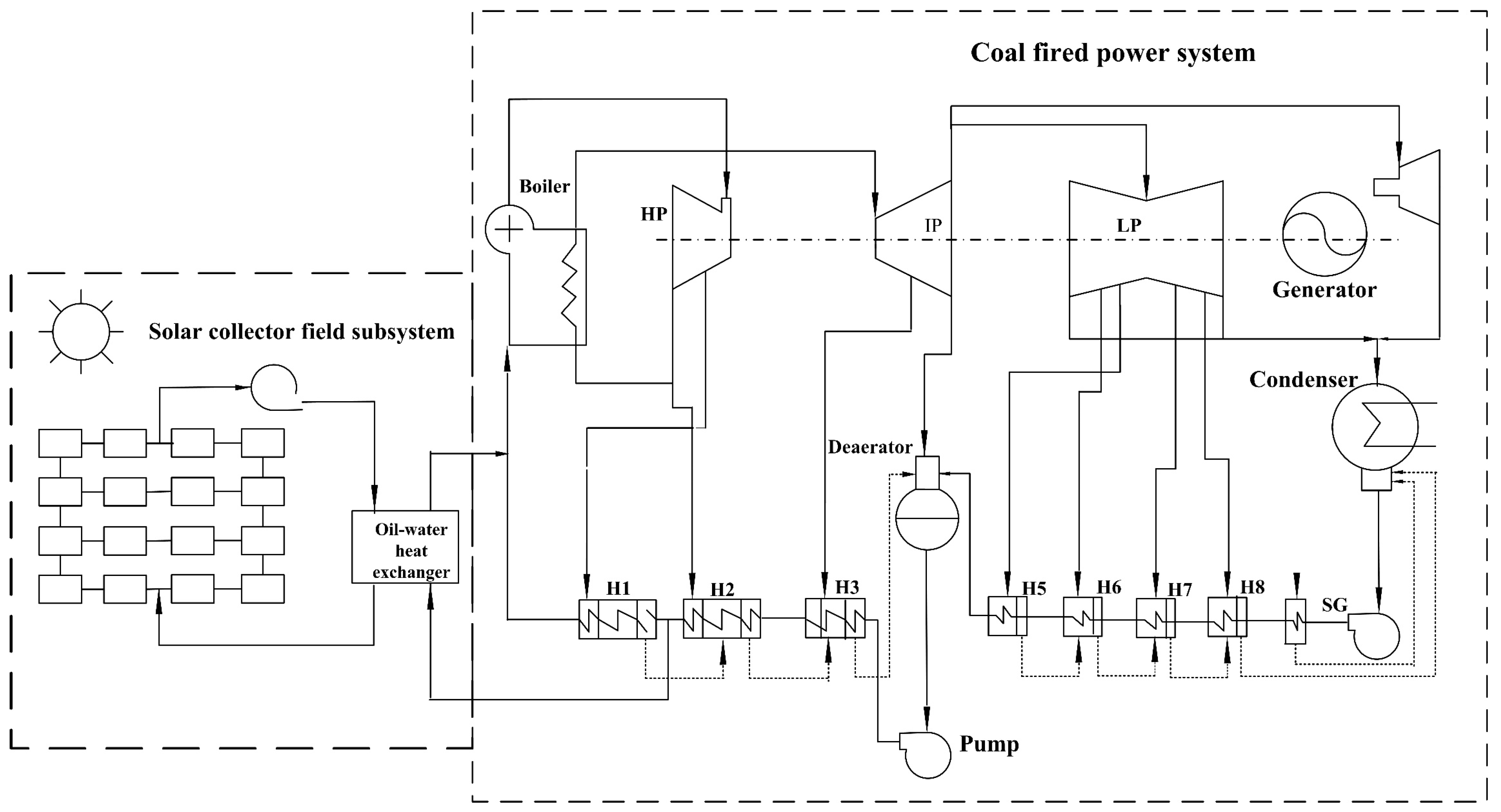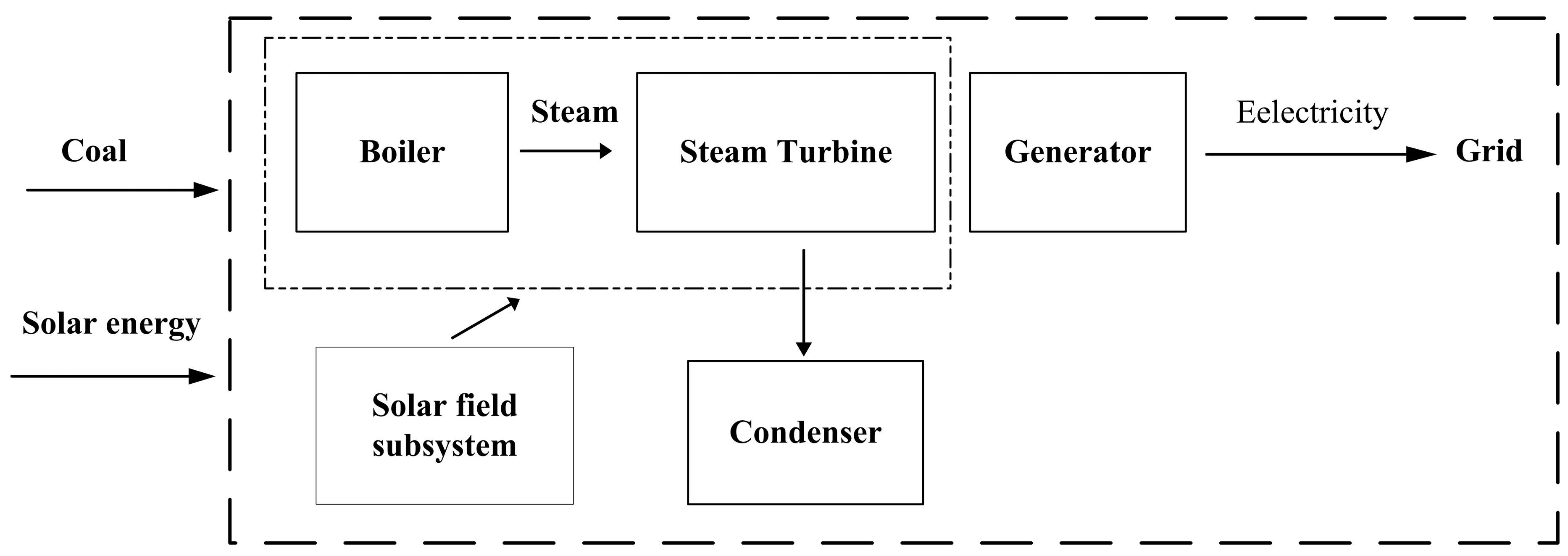3.1.1. Assumptions
The solar energy in a SACPG system is taken as an aid to the operation of the coal-fired power system because the capacity of the solar field subsystem is usually smaller than that of the coal-fired system in the hybrid system. When the solar energy is integrated, the coal-fired power system may run under off-design conditions, which can result in a decrease in the efficiency of the coal-fired power system. The benefits from the solar energy integration will be offset by the efficiency change of the coal-fired power system. In order to indicate the overall effects of the integration on the performance of a SACPG system, the efficiency change of the coal-fired power system may be attributed to the solar field subsystem. It can be assumed that the efficiency of the coal-fired system is not affected by the integration of the solar energy, and the coal-fired system with no solar energy integration can be defined as the baseline unit for the SACPG system. The coal-to-electricity efficiency of the baseline unit,
ηbr,scoal, can be defined in Equation (6).
where
Mbr,scoal is the amount of standard coal consumed by the baseline unit, in kg;
bbr,scoal is the standard coal consumption rate by the baseline unit, in g/kWh.
Therefore, the output electricity from the coal-fired system and the solar field subsystem can be, respectively, defined in Equation (8) and Equation (9) on the basis of the
ηbr,scoal and the annual power generation.
where
EGSACPG,y is the net output electricity of a SACPG system in year
y, in kWh;
EGcoal,y is the net output electricity of the coal-fired system in the SACPG system in year
y, in kWh;
EGsolar,y is the net output electricity of the solar field subsystem in year
y, in kWh;
Mc,y is the amount of standard coal consumed by the SACPG system in year
y, in kg;
ηbr,scoal,y is the average coal-to-electricity efficiency of the baseline unit in year
y.
According to the above analysis and Equations (8) and (9),
ηbr,scoal,y is the key factor to determine the allocation of the output electricity to solar energy and coal, for the net output electricity of a SACPG system and its coal consumption can be measured and recorded. However, the
ηbr,scoal,y is affected by many factors, such as the load ratio, the intermittency of solar energy, the off-design conditions of the coal-fired system, etc. In order to overcome the uncertain impacts of
ηbr,scoal,y on the output electricity allocation, it may be a good choice that
ηbr,scoal,y has to be authoritatively determined and regulated by the government sector [
19], ensuring that the allocation method is transparent, conservative and accurate.
3.1.2. Analysis and Determination of ηbr,scoal,y
The determination of ηbr,scoal,y has to be based on the capacity and other parameters (pressure and temperature) of the coal-fired power system in a SACPG system, its load ratio, etc., and the analysis approach for ηbr,scoal,y is as follows.
(1) Determination of the rated standard coal consumption rate by the baseline unit
The capacity and the pressure of the baseline unit can be determined according to the relevant parameters of the coal-fired power system in a SACPG system. Then, on the basis of these parameters, the basic standard coal consumption rate by the baseline unit can be selected in
the norm of energy consumption per unit product of general coal-fired power set [
26], which is one of the standards of the People’s Republic of China. The relevant data are shown in
Appendix Table A1. In addition, because the energy consumption of the baseline unit is also affected by its local temperature and cooling system, the modified coefficient for local temperature can be calculated by Equation (10) [
26], and the modified coefficient for the cooling system can be selected from
Table A2. The rated standard coal consumption rate by the baseline unit can be calculated by Equation (11).
where
t is the annual average temperature of the location of the SACPG system, in °C;
mbt is the modified coefficient for local temperature;
mbcool is the modified coefficient for the cooling system;
bra,coal and
bs,coal are, respectively, the rated standard coal consumption rate and the basic standard coal consumption rate by the baseline unit, g/kWh.
(2) Calculation of the average load ratio of the SACPG system
Because the output electricity of a SACPG system, its operation hours and its coal consumption can be easily recorded and measured during the operation of the hybrid system, its average load ratio can be calculated by Equation (12).
where
CAPmax,gcoal is the maximum capacity of the coal-fired power system in the SACPG system, in kW;
Sh is the operation hours of the SACPG system in year
y, in hours;
laver,coal,y is the average load ratio of the SACPG system in year
y, in %.
(3) Determination of the average standard coal consumption rate by the baseline unit
The load ratio of the baseline unit in a SACPG system has an effect on its energy consumption. So, the modified coefficient for its average load ratio can be calculated by Equation (13) [
26]. Based on the rated standard coal consumption rate by the baseline unit and the modified coefficient for its average load ratio, the average standard coal consumption rate by the baseline unit can be calculated by Equation (14).
where
mbr,scoal,y is the modified coefficient for the load ratio of the baseline unit in year
y;
bbr,scoal,y is average standard coal consumption rate by the baseline unit in year
y, in g/kWh.
(4) Determination of ηbr,scoal,y
According to the above analysis of
bbr,scoal,y and Equation (6),
ηbr,scoal,y can be determined from Equation (15).
Therefore, when the
ηbr,scoal,y of the baseline unit is determined, the output electricity allocation in a SACPG system can be calculated by Equations (8) and (9), and
ηbr,scoal,y is the critical factor for the output electricity allocation. During the above analysis of
ηbr,scoal,y, the data selected in the document,
the norm of energy consumption per unit product of general coal-fired power set, are obtained authoritatively through the relevant statistical analysis of the operation of the coal-fired power units, and the data are also updated regularly by the relevant government sectors. A SACPG system may be built either from a coal-fired power unit with the integration retrofit of the solar energy before the SACPG system project starts, or from a new coal-fired power unit with the solar energy integration, and the relevant data for the calculation of the
ηbr,scoal,y of its baseline unit can also be selected in
Appendix Table A1 to meet the requirements of the methodology.
If the actual coal-to-electricity efficiency of the coal-fired power system in a SACPG system is greater than the ηbr,scoal,y of its baseline unit, part of the efficiency of the coal-fired power system is attributed to the solar field subsystem as a reward, increasing the output solar-to-electricity. If the actual coal-to-electricity efficiency of the coal-fired power system is not greater than the ηbr,scoal,y, there is no such a reward. Thus, the analysis method of ηbr,scoal,y can encourage the coal-fired power system in a SACPG system to be retrofitted for the efficiency improvement, and also can encourage SACPG systems to be built in solar-rich areas.






